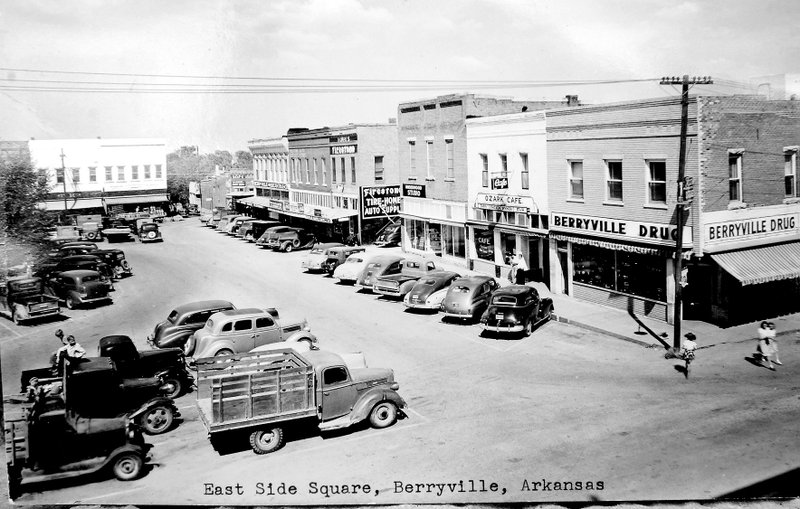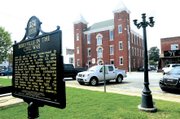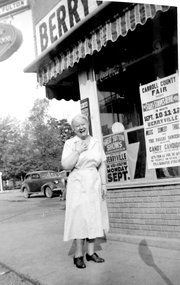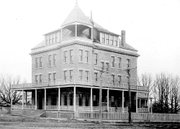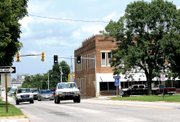Bruce Plumlee remembers time he spent on the Berryville square as a teenager. Fifteen or 20 teens would hang out there most of the night -- until 4 or 5 a.m., he recalled.
A night watchman was employed in those days, "but he didn't have any trouble, not from the kids," Plumlee said. "Of course, that was back when there were 1,500 people in town."
That same square and the surrounding historic district -- now in a town of 5,000-plus people -- earned a listing on the National Register of Historic Places earlier this year.
The square and commercial buildings have served as the central business district for Berryville and the area since the 1850s, according to the nomination papers for the national register.
"The buildings of the Berryville Commercial Historic District are largely in good condition and retain adequate integrity to convey their significance as components of a late 19th century to mid-20th century central business district," the nomination reads. "It is representative of the type of commercial center associated with the establishment of a county seat in a rural county."
The historic district includes 40 structures that retain their historical character and "contribute" to the district, and two buildings hold their own listings on the registry.
The square was laid out during the 1850 platting of the town, according to the nomination. In the 1890s, a town park was created in the middle of the square on an octagonal plan, with a well and gazebo in the middle. A hitching rail surrounded the park, providing Carroll County residents a place to tie up their wagons and teams while they shopped.
By 1960, the park had been changed from an octagon to an oval shape, with an outer ring of parking spaces to accommodate automobiles. By 1973, U.S. 62, a four-lane road running from Mexico to Canada, bisected the park. Today, each half of the park includes a fountain and wooden gazebo.
The park also includes two historical markers, describing the courthouses of Carroll County. A log structure in 1825 at Carrollton was first. A second of brick burned in 1859. "Another courthouse was built of brick on the same site after the war of secession and continued in use until the removal of the county seat [from Carrollton] to Berryville in 1880," the marker reads.
"The county was named in honor of Charles Carroll of Carrollton, a signer of the Declaration of Independence," it concludes.
The second marker commemorates Berryville's role in the Civil War, with troops of both sides skirmishing in the town. "By 1865, most of the town was in ruins," the marker reads. Six Union soldiers and six black teamsters were killed and buried in the city cemetery.
The park also includes a veterans' memorial, dedicated to "all Carroll County veterans who served in wars and conflicts."
The post office, built in 1938, is listed on the National Register, along with the three-story brick 1880s courthouse, which today houses the museum of the Carroll County Historical and Genealogical Society.
Townsfolk also are proud of the St. George hotel -- renamed the Grandview, which is what the locals call it -- although changes over the years have buried many of its historical features. Local builder Hardy Beal built the hotel with locally manufactured bricks in 1901 and 1902. The hotel offered 20 rooms and two bathrooms for guests. In 1910, wraparound verandas were added to each floor. Today, the hotel is physically surrounded by local shops, and an effort is under way to restore the building.
The historic square through the years was home to a harness shop; dry goods stores, groceries and mercantiles; a hardware store; a blacksmith's forge; car dealerships; a bus station; and the hall of the International Order of the Oddfellows. Cafes, boutiques, law and insurance offices, a barbershop, a tire store, a used bookstore and electronics store, a pharmacy and more line the sides today.
The Berryville Community Restoration Project's work is visible in murals painted on the sides of buildings at each corner of the square.
GOING DOWNTOWN
Shirley Pyron, a 40-year member of the historical society and the group's current editor, told a story that raged through the Smith-Brown building, currently home to Poyner Drug. Dr. Brown, a dentist, had offices on the top floor in the late 1920s to early 1930s.
"He hadn't had the business long," Pyron said, when Brown mounted the side steps to return to his office after lunch. "At that same time a patient tossed a smoking cigar or cigarette in the trash, and the first thing they knew, the whole place was on fire."
Brown's escape down the stairs was blocked, "but he went out the window and swung on some kind of wire -- some electricity must have come to Berryville by then. He dropped down and escaped that a way," Pyron said.
And there was a time when teenagers did cause trouble on the square.
O. Riley and his family lived above the Gentry building next to the courthouse. During the late 1930s, he operated a barber shop and a grocery downstairs and served the town as a constable.
A hitching rail with a heavy chain running from pole to pole used to circle the oval-shaped park for folks to tie their horses, buggies and wagons when they came to town, Pyron explained.
The opinions of that hitching rail varied between the merchants on the square and country folk of of Carroll County.
"Now, those horses and buggies left a lot of 'souvenirs,' and not everybody had screens (on their windows) in those days," Pyron explained.
"One night, all the graduating boys became quite the notable citizens of the town," she continued. "They tore down that old hitch. It took them all night to do it. It was quite an undertaking.
"The people who owned businesses around the square noticed but were not upset."
But then Mr. Holland came to town. Because the hitching rail was missing, he hitched his wagon and team to a tree.
Riley, who stood on a second-story porch overlooking the square, ran down and told Holland he couldn't do that, Pyron related. "But Mr. Holland said he reckoned he could," Pyron said.
The argument continued, and Riley hit Holland over the head with his constable's billy club.
"And Mrs. Riley, seeing the whole thing from the porch, came running down the side stairs brandishing a pistol," Pyron said, closing her tale.
Rumors also abound that outlaw Cole Younger stood trial upstairs in the courthouse that still stands.
"And there's a legend that a man was killed on each corner of the square, but I can't confirm that," Pyron concluded.
NAN Our Town on 08/18/2016

